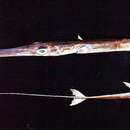Trophic Strategy
provided by Fishbase
Inhabits coral reefs (Ref. 58534). Found in the sublittoral zone (Ref. 11230); inhabits coastal areas over soft bottoms, usually at depths greater than 10 m (Refs. 30573, 127989). Benthopelagic (Ref. 58302). Feeds on small fishes and shrimps (Refs. 3401, 127989).
Morphology
provided by Fishbase
Dorsal spines (total): 0; Dorsal soft rays (total): 13 - 15; Analspines: 0; Analsoft rays: 14 - 15
Diagnostic Description
provided by Fishbase
With a row of bony plates along the midline (absent in F. commersoni); reddish or brownish-orange in color (whereas F. commersoni is greenish-brown).
Biology
provided by Fishbase
Found in the sublittoral zone (Ref. 11230); inhabits coastal areas over soft bottoms, usually at depths greater than 10 m (Ref. 30573). Benthopelagic (Ref. 58302). Feeds on small fishes and shrimps (Ref. 3401). Maximum length reported is 200 cm TL (Ref. 26999), however, no specimen over 100 cm is known to J.E. Randall (Ref. 11441).
Importance
provided by Fishbase
fisheries: subsistence fisheries
分布
provided by The Fish Database of Taiwan
廣泛分布於三大洋。臺灣各地海域及離島均有分布。
利用
provided by The Fish Database of Taiwan
以流刺網、一支釣及拖網均會捕獲。為味美刺少之食用魚,但吃過的人並不多。通常以新鮮的、鹽醃的、乾燥的或是煙燻後在市場上銷售,但是更常製成魚粉。
描述
provided by The Fish Database of Taiwan
體延長而側扁,後方圓柱形。吻延長為管狀。口小;頜齒小。兩眼間隔凹入。體側具微細小棘;尾柄部之側線上具向後尖出之稜鱗。背及臀鰭基底短而相對,具軟條14-17;胸鰭軟條15-17;腹鰭小;尾鰭深叉形,中央二鰭條延長成尾絲。生活時,體為一致之紅色。
棲地
provided by The Fish Database of Taiwan
主要棲息於軟質底部上的沿岸區域,棲息深度通常超過10公尺以上。平時成群或單獨靜止於水層中,靠身體尾部小幅度之擺動前進。肉食性,以長吻吸食小魚或蝦類。有時會模擬水中漂浮棍棒。
Red cornetfish
provided by wikipedia EN
The red cornetfish (Fistularia petimba), also known as the rough flutemouth, is a cornetfish of the family Fistulariidae, found in subtropical and tropical oceans worldwide, at depths between 10 m (33 ft) and 200 metres (660 ft). They are up to 2 m (6.6 ft) in length but rarely exceed 1 m (3.3 ft).[3][2]
In Japan, they are called akayagara (Japanese: 赤矢柄; アカヤガラ; "red arrow shaft"), or sometimes teppō (鉄砲 or 鉄炮; てっぽう; "rifle (fish)").
Range
Fistularia petimba is widespread in warmer parts of the Atlantic Ocean and Indo-Pacific, including the waters of Australia and Hawaii.[2] It has also been recorded on rare occasions in the Mediterranean Sea.[4] The species mostly lives in subtropical regions. In tropical areas, it tends to occur deeper or in places with cold upwellings.[1]
Biology
It occurs between 10–200 m (33–656 ft) depth, but most often at depths of 18–57 m (59–187 ft) over soft substrates.[2] It is an oviparous species which lays large pelagic eggs which hatch into larvae of 6–7 millimetres (0.24–0.28 in),[5] the juveniles move into estuarine habitats.[1] This species is a crepuscular,[1] stealthy predator which stalks its prey by moving slowly towards shoals of small fish, using its slender form to hide, and when it is close enough to its prey it darts forward and sucks it into its mouth.[5]
References
- Tony Ayling & Geoffrey Cox, Collins Guide to the Sea Fishes of New Zealand, (William Collins Publishers Ltd, Auckland, New Zealand 1982) ISBN 0-00-216987-8

- license
- cc-by-sa-3.0
- copyright
- Wikipedia authors and editors
Red cornetfish: Brief Summary
provided by wikipedia EN
The red cornetfish (Fistularia petimba), also known as the rough flutemouth, is a cornetfish of the family Fistulariidae, found in subtropical and tropical oceans worldwide, at depths between 10 m (33 ft) and 200 metres (660 ft). They are up to 2 m (6.6 ft) in length but rarely exceed 1 m (3.3 ft).
In Japan, they are called akayagara (Japanese: 赤矢柄; アカヤガラ; "red arrow shaft"), or sometimes teppō (鉄砲 or 鉄炮; てっぽう; "rifle (fish)").
- license
- cc-by-sa-3.0
- copyright
- Wikipedia authors and editors
Description
provided by World Register of Marine Species
Inhabits coastal areas over soft bottoms, usually at depths greater than 10 m. Feeds on small fishes and shrimps (Ref. 3401). A species with a row of narrow bony plates along the side of the body (Ref. 2334) and of reddish or brownish-orange color (Ref. 3132).
Froese, R. & D. Pauly (Editors). (2023). FishBase. World Wide Web electronic publication. version (02/2023).
- license
- cc-by-4.0
- copyright
- WoRMS Editorial Board
Diet
provided by World Register of Marine Species
Feeds on small fishes and shrimps
North-West Atlantic Ocean species (NWARMS)
- license
- cc-by-4.0
- copyright
- WoRMS Editorial Board
Distribution
provided by World Register of Marine Species
Western Atlantic: 41.2°N to southeastern Florida, USA to Central America
North-West Atlantic Ocean species (NWARMS)
- license
- cc-by-4.0
- copyright
- WoRMS Editorial Board
Habitat
provided by World Register of Marine Species
Inhabits coastal areas over soft bottoms, usually at depths greater than 10 m.
North-West Atlantic Ocean species (NWARMS)
- license
- cc-by-4.0
- copyright
- WoRMS Editorial Board
Habitat
provided by World Register of Marine Species
benthic
North-West Atlantic Ocean species (NWARMS)
- license
- cc-by-4.0
- copyright
- WoRMS Editorial Board
Habitat
provided by World Register of Marine Species
Known from seamounts and knolls
Stocks, K. 2009. Seamounts Online: an online information system for seamount biology. Version 2009-1. World Wide Web electronic publication.
- license
- cc-by-4.0
- copyright
- WoRMS Editorial Board

